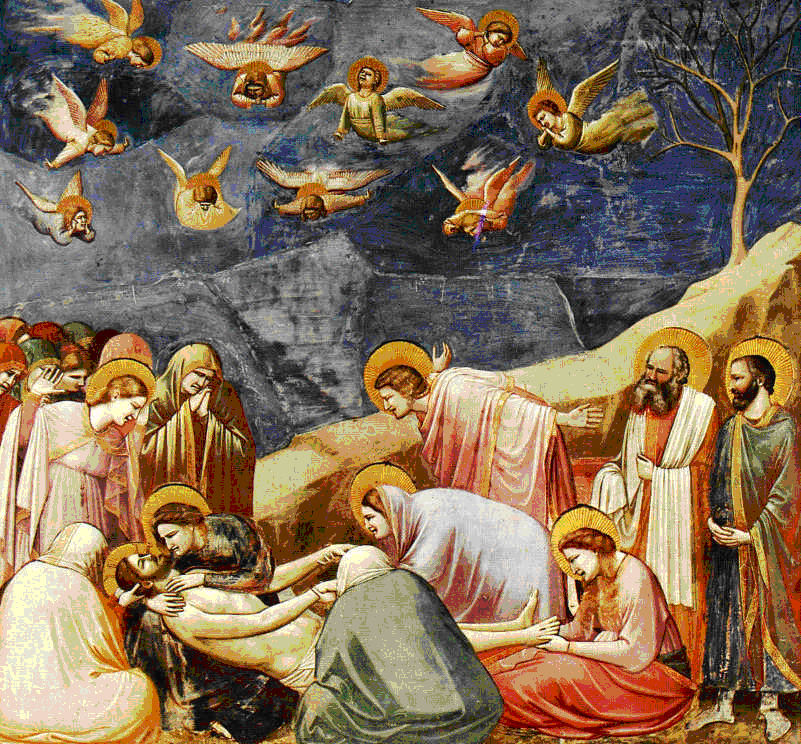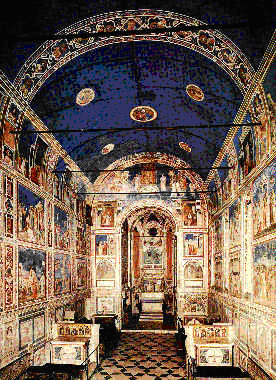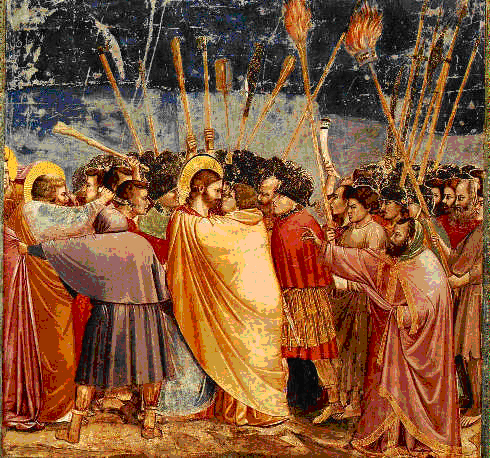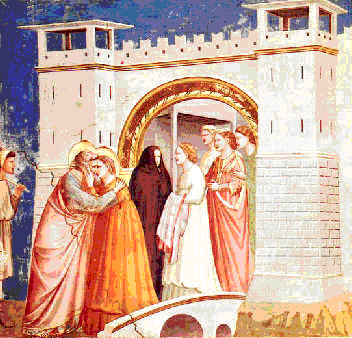
Reserved Area
Artists - ArtWorks
Giotto da Bondone, Cappella degli Scrovegni, Padova
 Italy
ItalyGothic Art and Architecture in Italy
1266-1337.
He is born in Vespignano Hill from Bondone father, farmer. According to the tried tradition he is student of Cimabue. In 1290 he works to Assisi in the Basilica of S. Francisco. At the beginning of 1300 he is in Padova where he frescoes the Scrovegni’s chapel. Giotto's masterwork is the decoration of the Scrovegni Chapel in Padua, commonly called the Arena Chapel, completed around 1305. This fresco cycle depicts the life of the Virgin and the life of Christ. It is regarded as one of the supreme masterpieces of the Early Renaissance. After 1300 he is active in Florence, stays also in Naples and Milan in order, to execute today lost frescoes. That Giotto painted the Arena Chapel and that he was chosen by the commune of Florence in 1334 to design the new campanile (bell tower) of the Florence Cathedral are among the few certainties of his biography. Almost every other aspect of it is subject to controversy: his birthdate, his birthplace, his appearance, his apprenticeship, the order in which he created his works, whether or not he painted the famous frescoes at Assisi, and where he was eventually buried after his death
In his Lives of the Artists, Giorgio Vasari relates that Giotto was a shepherd boy, a merry and intelligent child who was loved by all who knew him. He was discovered by the great Florentine painter Cimabue, drawing pictures of his sheep on a rock. They were so lifelike that Cimabue approached Bondone and asked if he could take the boy as an apprentice.[2] Many scholars today consider the story legendary and think it more probable that Giotto's family was well-off, and had moved to Florence where Giotto was sent to Cimabue's workshop as an apprentice.. He dies in January 8th in Florence.
Painting
The painters before Giotto still endure bizantine influences. Giotto frees the Italian art from the bizantini outlines, referring itself to classic sources that allow him to found a new language.
Giotto was a student of Cimabue, another great Italian master. Following Cimabue's artistic guidelines, which were heavily influenced by Medieval Greek and Byzantine paintings, Giotto painted his Jesuses, Madonnas and Childs, Saints and other religious beautifully preserved masterpieces. However, unlike his master, Giotto brought to the rigidly, schematic Byzantine style the expressiveness, spirituality, grace and liveliness of natural models. In Giotto's works human beings are living individuals. In the great tradition of Christian drama they act out their roles in sacrifice, crucifixion, redemption and resurrection with devout passion.
Literature
The Divine Comedy (Italian: Commedia, later christened "Divina" by Giovanni Boccaccio), written by Dante Alighieri between 1308 and his death in 1321, is widely considered the central epic poem of Italian literature, and is seen as one of the greatest works of world literature.[1] The poem's imaginative and allegorical vision of the Christian afterlife is a culmination of the medieval world-view as it had developed in the Western Church. It helped establish the Tuscan dialect in which it is written as the Italian standard.
Political context
In central and northern Italy during the 12th and 14th centuries the Guelphs and Ghibellines were factions supporting, respectively, the Papacy and the Holy Roman Empire.
The division between Guelphs and Ghibellines was especially important in Florence, although the two sides frequently rebelled against each other and took power in many of the other northern Italian cities as well. Essentially the two sides were now fighting either against German influence (in the case of the Guelphs), or against the temporal power of the Pope (in the case of the Ghibellines). In Florence and elsewhere the Guelphs usually included merchants and burghers, while the Ghibellines tended to be noblemen. They also adopted peculiar customs such as wearing a feather on a particular side of their hats, or cutting fruit a particular way, according to their affiliation.
In Assisi Giotto knows important painters of the age, like Cimabue, Jacopo Torriti and Simone Martini. Italy in the end of 1200 becomes said earth city, and in that age only Paris had the dimensions of one great Italian city. The so-called gross readings are born in those years, in Florence, and will produce the poetry language of Dante Alighieri in the Divine Commedia.
Regarding the artists of his time, Giotto abandons the Bizantini ways definitively, imposes attention to natural, architectonic spaces, and the human figure, that will produce the principal characters of Italian rinascimentale art.
Cimabue expressed in his art a sort of relationship with the Neoellenistic art from Bisanzio, and also a relationship with the Romanic and Expressionst Art. Cimabue’s most famous work is “Il Crocifisso” in San Domenico di Arezzo, in which he perfectly expressed a Medieval Character with dramatic tones and static images. In 1288 Cimabue worked on the frescoes in the Chiesa Superiore di Assisi, that became his famous works. In those frescoes the artist showed a renovation and a new sense of monumentality.
The Roman painter, Pietro Cavallini, got inspired by the Bizantine Culture and a little bit by the Paleochristian art. His masterpiece “Il Giudizio Universale” in Santa Cecilia in Rome has a great sense of humanity that makes the Bizantine style a little bit milder. The style of Cavallini was influenced from Giotto, especially regarding his works in Santa Maria d’ Aracoeli in Rome.
Ambrogio Lorenzetti owned some similar aspects of Giotto’s style. In his work “l’Annunciazione” he used some fundamentals of perspective, that became very important in the art of XlV century. In Tuscany some aspects og Giotto’s style became very important , which have been often combined together with an international sense of gothic. The most important painters in Siena were: Simone Martini, Duccio di Boninsegna, Pietro and Ambrogio Lorenzetti.
The themes chosen by Giotto and the layout of the scenes create a narrative cycle alluding to salvation, full of corresponding and parallel elements, symbolic meanings and formal innovations, all of which can be interpreted in a number of ways and with different nuances of meaning. The Golden legend, the Apocrypha as well as classical works and texts from the Franciscan devotional rite. The iconography of the decoration is clearly the work of a man who was well-versed in theological matters.
In the XIII and XIV sec. in Italy an independent tradition is developed, tied to the classic and bizantina art, that constitutes fertile ideas for the new composition searches and spaces of Cimabue, Giotto and senesi artists, and the position to elaborate models that assimilates to the international gotico.
In France the Rayonnant style evolved about 1280 into an even more decorative phase called the Flamboyant style, which lasted until about 1500. In England a development known as the Perpendicular style lasted from about 1375 to 1500. The most conspicuous feature of the Flamboyant Gothic style is the dominance in stone window tracery of a flame like S-shaped curve. In the Flamboyant style wall space was reduced to the minimum of supporting vertical shafts to allow an almost continuous expanse of glass and tracery.
In England the parallel Perpendicular Gothic style was characterized by predominance of vertical lines in the stone tracery of windows, an enlargement of windows to great proportions, and the conversion of the interior stories into a single unified vertical expanse.
In Padua Giotto resorts to Roman suggestions as will happen more systematically for some Renaissance artists; the bas-reliefs of the false plinth that for instance seem a terrestrial ideal crop for the Mantega and some solutions of Ferrarese Workshop but not only (for example the "Libel" by Botticelli, preserved in Florence Offices, with its bas-reliefs that adorn the building where the unfair trial consumes).
In Padua, unlike Assisi, the space is articulated by architectures represented in the painted (while in the frescoes of Assisi the architecture of the cathedral "scan" the painted scenes), the human figures become more numerous: the architecture structure and model with greater awareness and precision filled void with believable dimensions, from the human bodies; depth and proportional surrender result more convincing, that is realistic, of the Byzantine art and mostly investigate than it happened to Assisi.
A search of great realism culminates then, in the cycle of Padua, with two "coretti" paintings that almost "smashing" the wall of support (as will happen hundred years later in the Trinity of Masaccio, S. Maria Novella, where recalls Vasari, viewers of one time stayed surprised by that wall that seemed laundry so much it appeared convincing, for that time, the representation of the depth) and that denote a great ability illusionistica, almost from "Tromple l'oeil", in to mime the spatial depth, an ability that seems directly inherited by the distant the Roman domuses distant, almost antithetical, to the bysantine spazialita dominated by the so-called capsized perspective. And also the sky, that is glimpse by the windows bifore, renouncement to the transmarine tonality, and almost "metaphysical" that submerges the narrated epispdis, to welcome misty and more consistent tonality to the padovano environment.
With Giotto begins the Italian art that will culminate with Michelangelo, Raffaello and Leonardo8) JUSTIFICATION with Giotto begins that Italian art that will culminate according to Vasari, painter and biographer aretino of the 1500, author of "The Lives of the artists," with Michelangelo, Raphael and Leonardo. Consider only the attention for the human body in Giotto (without forwarding in the architectural space previously mentioned): a meaningful example could be the Crucifix giottesco of Santa Maria Novella in Florence, performed in 1296-1300 and that of Cimabue of Santa Cross of 1280 in Florence and jeopardized by the flood of 1966: Giotto abdicates the Byzantine emphasis of the face of Our traceable Lord in Cimabue and with great determination knows hoe to abdicates to a certain grafismo, perhaps more evident in Crucifix of Arezzo painting ten years before from the same Cimabue, that allows him to realize a more solid plasticity, compote, endowed with a remarkable and concrete anatomical attention, few prone to the spasmodic torsions of Cimabue and that seems to preannounce, with a precision of clairvoyant, some Renaissance bodies.
G.C. Argan, Storia dell’rte italiana vol.2
C. Berteli, G. Briganti, A. Giuliano, storia dell’arte italiana vol.2
Giotto, Classici dell’arte, Rizzoli
http://www.giottoagliscrovegni.it/ita/visita/mappa_a.htm
http://www.christusrex.org/www1/giotto/virtues.html
http://en.wikipedia.org/wiki/Giotto_di_Bondone
Related Material:
Image available

File name: 25_giotto1.jpg
Description of the material:
four versions (JPG) 42k 140k 224k 415k Good image. There are many details. Is a very large size image.
Contextualisation Of the source:
http://www.christusrex.org/www1/giotto/christ2.html the site is abounded in pictures of Cappella of Scrovegni
Interpretation of the source:
In the Mourning on died Christ, scene draft from the cycle of frescoes located in the Nail head of the Scrovegni of Padova, Giotto paints with great expressive force a landscape occupied from the traditional present figures in the iconography of the Mourning. The perspective realism with which the subjects are dipped in the space reveals already the new formulation spaces studied from Giotto. Not more the bidimensional space of the art bizantina and medieval high, but the three-dimensional and naturalistic one of the classic tradition. The representation of the space from more points of view, is the contingent space, in which the man lives and operates. The composition is divided from one tactilely perceptible diagonal in the three-dimensional reproduction, like crest, that divides the space of the scene of the Mourning from the landscaped space. It overhangs with the blue sky, in which we find suspending angels, sharing in their tormented flight and crying the pain of the observers.

File name: 25_giotto2.jpg
Description of the material:
There are three versions of pictures: Small 70k Normal 132 Large 256 then there are many viewpoints of the chapel jpg. Good image medium size. Photo wide shot. It’s visible both wall faces with the universal judgment and sidewalls and the vault decorated with the splendid blue colour of lapis lazuli.
Contextualisation Of the source:
http://www.christusrex.org/www1/giotto/scrovegni.html the site is abounded in pictures of Cappella of Scrovegni
Interpretation of the source:
Sometime between 1303 and 1310 Giotto executed (and signed) his most influential work, the painted decoration of the interior of the Scrovegni Chapel in Padua. This chapel, the building and decoration of which were commissioned by Enrico degli Scrovegni to atone for the sins of his father, is externally a very plain building of pink brick which was constructed next to an older palace that Scrovegni was restoring for himself. The palace, now gone, and the chapel were on the site of a Roman arena, for which reason it is commonly known as the Arena Chapel. The cycle is divided into 37 scenes, arranged around the lateral walls in 3 tiers, starting in the upper register with the story of Joachim and Anna, the parents of the Virgin and continuing with the story of Mary. The life of Jesus occupies two registers. The Last Judgment fills the entire pictorial space of the counter-façade.

File name: 25_giotto3.jpg
Description of the material:
There are four versions of the picture (JPG): 79k 228k 232k 423k Good picture. Very large size. The details of the dramatic scene are as visible as are visible the fresco days.
Contextualisation Of the source:
The picture is in: http://www.christusrex.org/www1/giotto/christ2.html the site is abounded in pictures of Cappella of Scrovegni
Interpretation of the source:
This dramatic scene takes place at night. Torches shine out among the sticks and halberds against the blue of the sky. The throngs of people crowd into the centre, towards Christ, who is betrayed by Judas' kiss. Every movement, even that of Peter as he cuts off the ear of an attacker, and every gaze heightens the tension of the central confrontation. With the force of his body Judas presses against Christ, who appears to disappear beneath the traitor's cloak. This expresses the inevitable outcome of this overwhelming confrontation. Surrounded and hemmed in by numerous faces, the profiles of Christ and Judas almost collide. The two look at one another — the one with dignity and seriousness, the other full of malice. The whole drama of the event is captured in this infinitely long exchange of glances.

File name: 25_giotto4.jpg
Description of the material:
four versions (jpg) 29k 69k 169k 221k Good picture. Very large size. The high quality allows to see the superficial pittorica in a detailed way.
Contextualisation Of the source:
The picture is in: http://www.christusrex.org/www1/giotto/joachim.html the site is abounded in pictures of Cappella of Scrovegni
Interpretation of the source:
Joachim and Anna follow the angels directive to go to the Golden Gate in Jerusalem. Here they are united for the first time since Joachim left home and share the knowledge of the impending birth that will change their lives forever. There are a number of scenes in the chapel that deal with farewells or reunions, none is more famous than this. Their private and intimate embrace form a sort of pyramid that isolates them from the onlookers. There has been discussion, but little agreement, about the identity of the woman in black. She seems to be the only person not happy with the reunion.
Comments about this Artist/ArtWork
Date: 2009.05.22
Posted by Nadia Petrova, NSA, Rousse, BG
Message: A nice video with artworks by Giotto - http://vbox7.com/play:024ef9c4. It can be viewed by any kind of audience. The images are not supproted by text, but the video shows some close ups on details from Giotto's paintings.
Michelangelo - Copyright 2008 - This project has been funded with support from the European Commission